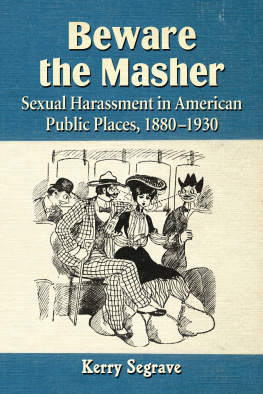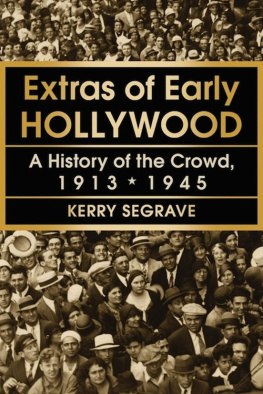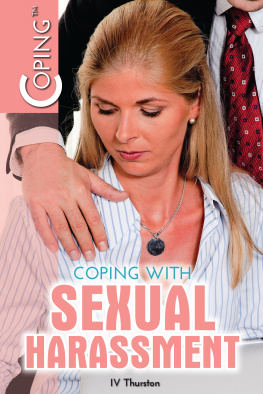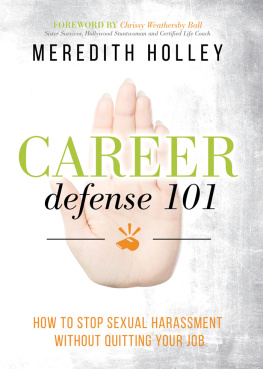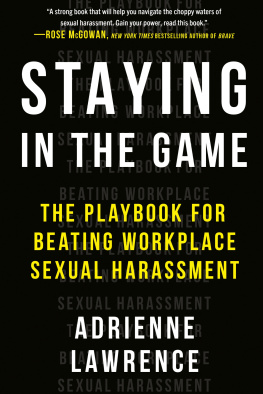
OTHER WORKS BY KERRY SEGRAVE AND FROM MCFARLAND
Policewomen: A History, 2d ed. (2014)
Extras of Early Hollywood: A History of the Crowd, 19131945 (2013)
Parking Cars in America, 19101945: A History (2012)
Begging in America, 18501940: The Needy, the Frauds, the Charities and the Law (2011)
Vision Aids in America: A Social History of Eyewear and Sight Correction Since 1900 (2011)
Lynchings of Women in the United States: The Recorded Cases, 18511946 (2010)
America Brushes Up: The Use and Marketing of Toothpaste and Toothbrushes in the Twentieth Century (2010)
Film Actors Organize: Union Formation Efforts in America, 19121937(2009)
Parricide in the United States, 18401899(2009)
Actors Organize: A History of Union Formation Efforts in America, 18801919 (2008)
Obesity in America, 18501939: A History of Social Attitudes and Treatment (2008)
Women and Capital Punishment in America, 18401899: Death Sentencesand Executions in the United States and Canada (2008)
Women Swindlers in America, 18601920 (2007)
Ticket Scalping: An American History, 18502005 (2007)
America on Foot: Walking and Pedestrianism in the 20th Century (2006)
Suntanning in 20th Century America (2005)
Endorsements in Advertising: A Social History (2005)
Women and Smoking in America, 1880 to 1950 (2005)
Foreign Films in America: A History (2004)
Lie Detectors: A Social History (2004)
Product Placement in Hollywood Films: A History (2004)
Piracy in the Motion Picture Industry (2003)
Jukeboxes: An American Social History (2002)
Vending Machines: An American Social History (2002)
Age Discrimination by Employers (2001)
Shoplifting: A Social History (2001)
Movies at Home: How Hollywood Came to Television (1999; paperback 2009)
American Television Abroad: Hollywoods Attempt to Dominate World Television (1998; paperback 2013)
Tipping: An American Social History of Gratuities (1998; paperback 2009)
Baldness: A Social History (1996; paperback 2009)
Payola in the Music Industry: A History, 18801991 (1994; paperback 2013)
The Sexual Harassment of Women in the Workplace, 1600 to 1993 (1994; paperback 2013)
Women Serial and Mass Murderers: A Worldwide Reference, 1580 through 1990 (1992; paperback 2013)
Drive-in Theaters: A History from Their Inception in 1933 (1992; paperback 2006)
Beware the Masher
Sexual Harassment in American Public Places, 18801930
Kerry Segrave

McFarland & Company, Inc., Publishers
Jefferson, North Carolina
LIBRARY OF CONGRESS CATALOGUING DATA ARE AVAILABLE
BRITISH LIBRARY CATALOGUING DATA ARE AVAILABLE
e-ISBN: 978-1-4766-1461-8
2014 Kerry Segrave. All rights reserved
No part of this book may be reproduced or transmitted in any form or by any means, electronic or mechanical, including photocopying or recording, or by any information storage and retrieval system, without permission in writing from the publisher.
On the cover: A 1902 sketch showing mashers at work on L (elevated transit) cars, The Evening World, October 28, 1902, Night Edition, Page 12 (LIBRARY OF CONGRESS)
McFarland & Company, Inc., Publishers
Box 611, Jefferson, North Carolina 28640
www.mcfarlandpub.com
Preface
This book looks at the history of sexual harassers in the public spaces in the United States over the period 1880 to 1930. During this period the term masher was the word used to describe the behavior. The masher committed a mash, or attempted to commit a mash. I chose the period covered by this book because the term used to describe the behavior and the behavior itself seems to have emerged around that time, in the very late 1870s. The end date was chosen because it marked an end to the very large and aimless public gatherings of males from which so much sexual harassment was initiated. It was those gatherings that gave rise to so many communities passing vagrancy and loitering laws. It was the car culture, though, that did the most to eliminate such gatherings. As well, by 1930 or so, the strongly held social norm that men did not talk to strange women in public places had weakened considerably. While it had not disappeared entirely, it was well on its way to extinction.
For the purposes of this book, a sexual harasser (masher) is one who harasses a woman he does not know in the public places in America, such as on the streets of the nations cities and on its transit vehicles.
Online databases were crucial in researching the subject of this book. Most useful were the LIBRARY OF CONGRESS, with its Chronicling America project, and newspaperarchive.com.
Introduction
Sexual harassment of women in the streets of America seems to have first become a problem around the very end of the 1870s. Prior to that time women had a more limited presence in the public spaces in the nation, at least on their own. The idea of the male protector who was always on hand to protect his woman was fading away. It had always been an upper-class phenomenon in any case, but the changing shape of the American landscape from rural to increasingly urban and industrial gave women more opportunity to be out and about on their own. The first feminist movement was well underway during the period covered by this book, and it demanded the right of free mobility, among other things. That increasing urbanization also meant an increasing anonymity for people in those ever-growing cities. It was harder to harass a woman in a small town, where everybody knew everyone else, than in a big city where anonymity was standard.
The first chapter of this book looks at the rules of conduct for people in social settings, specifically the rules for interacting with strangers in the public sphere. These were, of course, not laws but norms of social conduct. They exerted a strong control over peoples behavior. Also discussed are the names used over time to describe sexual harassment. Chapter 2 discusses the description and extent of the problem as seen by a wide variety of observers over time. Chapter 3 features editorials from newspapers throughout this period, which alternately decried the situation and offered solutions. Also included here are comments from other public opinion shapers, such as religious leaders and columnists.
Chapter 4 focuses on the apparently timeless tactic of blaming the victim. What was that woman doing there in the first place? Why was she wearing that? Why did she have that manner about her? Reading today about some religious leader in 1912 urging women to wear their skirts a little longer, almost to the ground, to ensure their ankles were not visible only reinforces the ridiculousness of such notions. Men of 1912 were driven uncontrollably mad by such wantonness, dont you know.
Chapters 5 through nine cover responses made by individual women to their harassers. Specifically covered in those chapters are women responding through words, women responding with their fists, women responding with weapons, responses delivered by a protector (such as a husband or father), and womens responses delivered by one or more bystanders (that is, people who did not know the harassed woman but stepped in to deal physically with the harasser).
Next page
